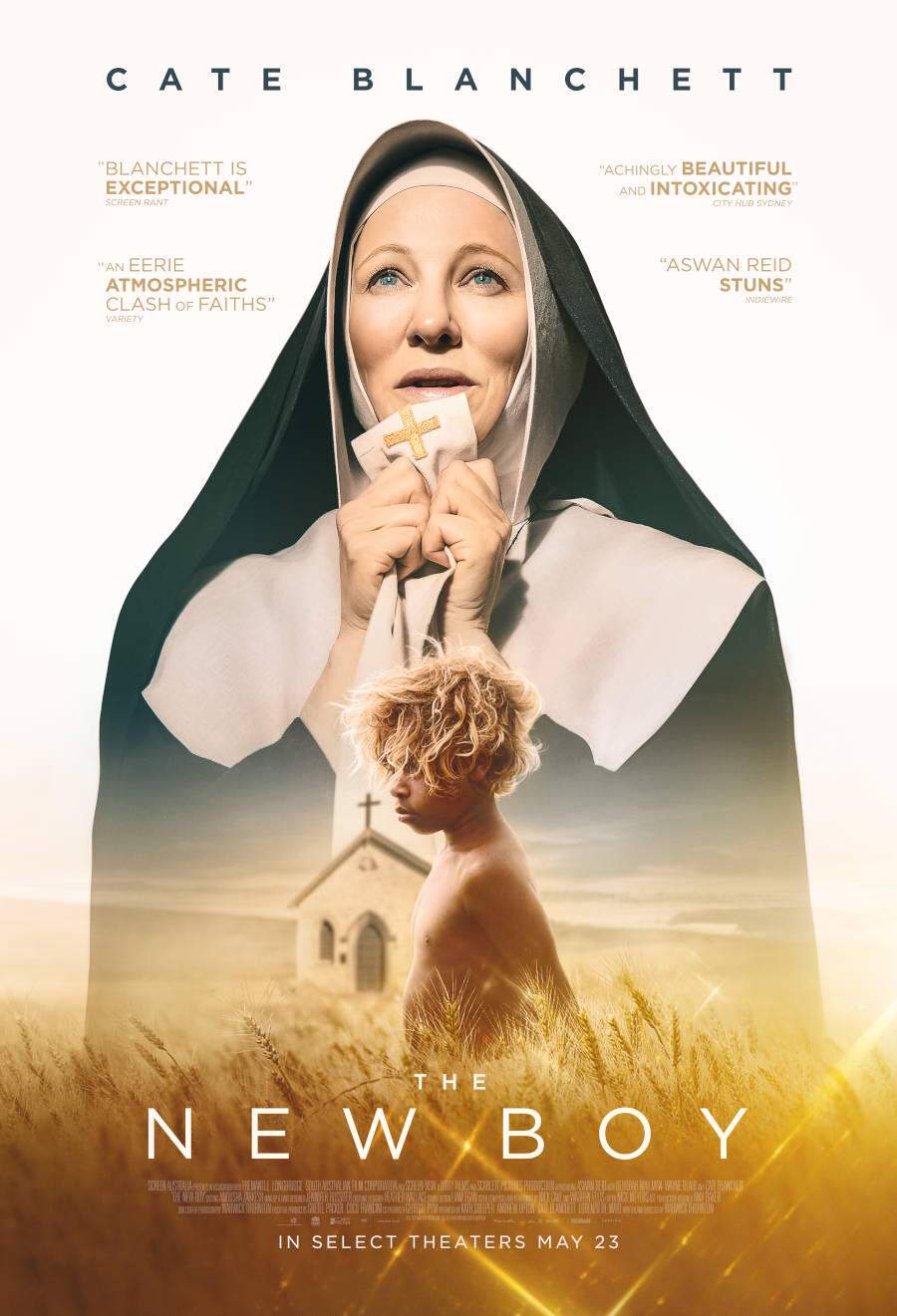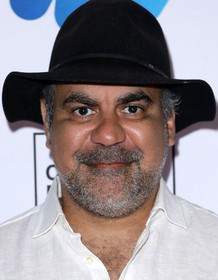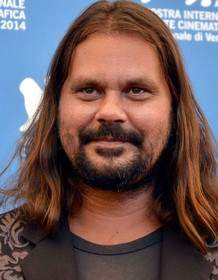The New Boy 2025

In 1940s Australia, a young Aboriginal boy unexpectedly arrives at a secluded monastery one night. Run by a defiant nun, the monastery's peaceful existence is disrupted by the boy's arrival, leading to a story exploring spiritual conflict and the challenges of survival.
Does The New Boy have end credit scenes?
No!
The New Boy does not have end credit scenes. You can leave when the credits roll.
Meet the Full Cast and Actors of The New Boy
Explore the complete cast of The New Boy, including both lead and supporting actors. Learn who plays each character, discover their past roles and achievements, and find out what makes this ensemble cast stand out in the world of film and television.

Cate Blanchett
Sister Eileen

Wayne Blair
George

Shane Brady
Michael

Deborah Mailman
Sister Mum

Kenneth Radley
Policeman 3

Aswan Reid
New Boy

Tyrique Brady
Matthew

Tyler Spencer
Johnny

Kyle Miller
James

Laiken Woolmington
David

Kailem Miller
Steven

Tyzailin Roderick
Henry

Nathan Lawson
Policeman 1

Peter Jupiter
Tracker

Kit Fortune
Policeman 2

Kobe-Miller Dare
Child in Photo 1

Lara Lorna McKenzie-Brady
Child in Photo 2

Les Rice
Truck Driver

Andrew Upton
Firefighter

Tyson Pawley
Firefighter
External Links and Streaming Options
Discover where to watch The New Boy online, including streaming platforms, rental options, and official sources. Compare reviews, ratings, and in-depth movie information across sites like TMDb, Wikipedia, Metacritic or JustWatch.
Ratings and Reviews for The New Boy
See how The New Boy is rated across major platforms like IMDb, Metacritic, and TMDb. Compare audience scores and critic reviews to understand where The New Boy stands among top-rated movies in its genre.

The Movie Echo Score
The New Boy stands out for its striking visual composition but is tempered by uneven pacing and narrative coherence. Drawing on warm color palettes and dynamic framings highlighted in several assessments, the film’s imagery consistently earns praise while its allegorical storytelling and deliberate tempo divide viewers. Performances by key leads offer notable emotional moments, but some critics found the character arcs and thematic clarity lacking. Overall, the film offers a distinctive cinematic experience that resonates visually more than narratively.
The Movie Echo Score Breakdown for The New Boy

Art & Craft
In terms of art and craft, the film’s visual design is a clear highlight. Cinematography bathed scenes in warm tones and a scorched ochre palette that critics described as gorgeously rendered. Direction employed dynamic compositions and restrained editing to underscore thematic undercurrents. These elements coalesce into a technically assured aesthetic throughout the runtime.

Character & Emotion
In terms of character depth and emotion, the film delivers notable performances with uneven development. Aswan Reid’s kinetic presence and Blanchett’s measured portrayals offer engaging moments, though several critiques pointed to unbalanced character exploration and minimalistic arcs that limit emotional resonance. Overall, the film’s character work is compelling in parts but lacks consistent depth.

Story & Flow
In terms of story and flow, the film’s deliberate pacing and allegorical approach yield mixed results. Several observers noted languid tempo that bogged down narrative momentum, while thematic ambiguity occasionally hindered engagement and plot coherence. While the initial sequences garnered praise for intensity, the film struggles to sustain narrative drive. Ultimately, its storytelling remains uneven.

Sensory Experience
In terms of sensory experience, the film offers immersive audiovisual elements that strongly engage the viewer. Critics highlighted its provocative imagery and warm, cohesive visual style, noting how static and dynamic sequences create atmospheric depth. Though specific soundtrack details were less emphasized, the combined use of sound design and imagery produces a striking sensory tapestry.

Rewatch Factor
In terms of rewatch factor, the film’s visual richness and thematic layers offer incentive for repeat viewing despite narrative inconsistencies. Several assessments pointed to unforgettable imagery and moments of emotional provocation that could reveal fresh insights on subsequent viewings. However, lingering ambiguities and uneven pacing may reduce its appeal over multiple screenings. Overall, the film rewards attentive revisits moderately.

64
Metascore
tbd
User Score

55
%
User Score

2.4
From 118 fan ratings
Take the Ultimate The New Boy Movie Quiz
Challenge your knowledge of The New Boy with this fun and interactive movie quiz. Test yourself on key plot points, iconic characters, hidden details, and memorable moments to see how well you really know the film.
The New Boy from 2025 Quiz: Test your knowledge on the themes, characters, and events of 'The New Boy from 2025'.
What country is the setting of 'The New Boy from 2025'?
Australia
New Zealand
Canada
South Africa
Show hint
Full Plot Summary and Ending Explained for The New Boy
Read the complete plot summary of The New Boy, including all major events, twists, and the full ending explained in detail. Explore key characters, themes, hidden meanings, and everything you need to understand the story from beginning to end.
In the heart of the Australian outback during the 1940s, a nameless nine-year-old orphan boy, who is of Aboriginal descent but has some fair hair, becomes embroiled in a dramatic turn of events when he strangles a white horseman. His actions quickly draw the attention of another horseman, who retaliates by felling the boy with a boomerang. This leads to the boy being taken in by a remote monastery, which serves as a refuge for Aboriginal boys. Curiously, the monastery is presided over by a male priest, who is, unbeknownst to the boys, long deceased; in fact, it’s been a year since he passed away. The head nun, Sister Eileen, cleverly maintains the façade of the priest’s existence, even going so far as to forge letters to convince outsiders of his continued presence.
Supporting her in this deception are two figures: a fellow nun affectionately known as Sister Mum and an Aboriginal man named George. Despite their good intentions, the nuns fail to impart any knowledge of Aboriginal culture, values, or language to the boys, leaving them ill-equipped for the realities of the world outside the monastery. Their future is largely dictated by the necessity to leave at a young age to work as farmhands, a fate that weighs heavily on their spirits. It’s suggested that Sister Mum’s conversion to Christianity stemmed from the deep pain of losing her two children, while George finds solace in the stability offered by the monastery life.
The orphan boy, often referred to as the New Boy, initially faces enormous challenges in adapting to his new environment. He struggles to communicate, lacking any proficiency in English, and shows little inclination towards adopting Western customs, such as clothing or shoes. After enduring a period of bullying from his peers, the New Boy begins to assert himself both physically and emotionally, ultimately finding acceptance among the other boys. Throughout his journey, the New Boy demonstrates remarkable supernatural abilities, enabling him to conjure small orbs of light and even heal sick animals and humans around him.
This fragile equilibrium is disrupted with the arrival of a large crucifix statue of Jesus for the monastery’s church. The New Boy finds himself inexplicably drawn to this statue, envisioning it alive, which ignites both fascination and fear among those around him. He begins offering live snakes to the statue, a practice met with horror by the other boys. Compounding his mystique, he starts experiencing stigmata in his hands, further blurring the lines of his supernatural gifts.
One pivotal moment occurs when the New Boy revives a dead snake, inadvertently causing a lightning strike that ignites a fire in the fields. This situation forces George and the boys into action to extinguish the flames. During this chaotic time, the New Boy, in front of the statue, pierces his hands to mimic the crucified Jesus, an act that initially shocks Sister Eileen. However, she interprets this as a sign of his acceptance of Christianity. When George and the other boys return to the monastery, they find that the eldest boy, Michael, has suffered injuries while battling the fire. The New Boy uses his powers to heal Michael, an event that leaves George and Eileen in awe.
As the New Boy’s strange and unorthodox attachment to Jesus continues to unsettle the adults and challenges the traditions they’ve cultivated, he occasionally reverts to his original, more playful state. In one instance, he secretly removes the statue to “play” with it, attempting to mend its crucifixion wounds and dress it up, until it’s discovered by Sister Eileen and put back in its designated place by George. Concerned that the New Boy has yet to fully relinquish his Indigenous ways, George makes the difficult decision to separate him from the other boys.
After grappling with her own beliefs, Sister Eileen comes to see the New Boy as a messenger from Christ, leading her to baptise him in an attempt to cleanse him of what she perceives as “sins.” Despite his limited comprehension of Christianity, the New Boy graciously accepts the baptism, but soon realizes it comes at a cost: he loses his previously held supernatural abilities. Embracing his new life, he begins to adopt Western clothing and footwear.
As the significant day, marked as V-day, approaches, the New Boy tentatively embarks on this new journey, experiencing a tentative sense of belonging from his peers. Yet, the resolution of his story leaves him at a crossroads, caught between two vastly different worlds and facing an uncertain future.
Uncover the Details: Timeline, Characters, Themes, and Beyond!
Watch Trailers, Clips & Behind-the-Scenes for The New Boy
Watch official trailers, exclusive clips, cast interviews, and behind-the-scenes footage from The New Boy. Dive deeper into the making of the film, its standout moments, and key production insights.
The New Boy Other Names and Titles
Explore the various alternative titles, translations, and other names used for The New Boy across different regions and languages. Understand how the film is marketed and recognized worldwide.
Articles, Reviews & Explainers About The New Boy
Stay updated on The New Boy with in-depth articles, critical reviews, and ending explainers. Explore hidden meanings, major themes, and expert insights into the film’s story and impact.
Quick Links: Summary, Cast, Ratings, More

What's After the Movie?
Not sure whether to stay after the credits? Find out!
Explore Our Movie Platform
New Movie Releases (2025)
Famous Movie Actors
Top Film Production Studios
Movie Plot Summaries & Endings
Major Movie Awards & Winners
Best Concert Films & Music Documentaries
Movie Collections and Curated Lists
© 2025 What's After the Movie. All rights reserved.













